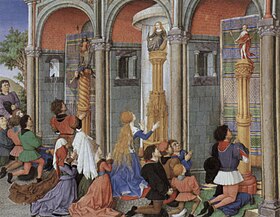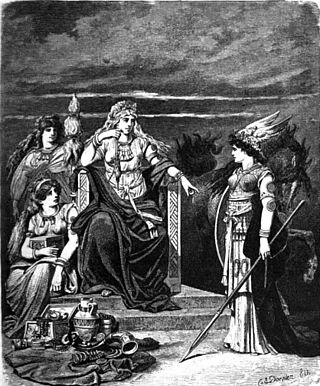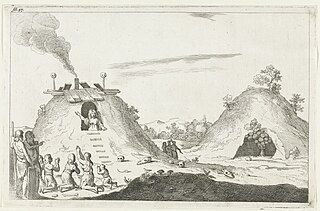Pre-Christian traditions
Deities

From ancient regional mythology, most names of ancient gods and goddesses in this region come from local tribal lore, particularly in the North. Many of the deities are the same as eastern Germanic Deities: Wodan is Dutch for Odin, the god of war and leader of the Wild Hunt. The Wild Hunt was retold in Dutch with Wodan leading under different guises: Gait with his dogs; Derk with his dogs; Derk with his boar; the glowing horse; Henske with his dogs.). [4] Donar is Dutch for Thor, the god of thunder.
In Dutch the days of the week are named for Germanic gods, a custom derived from parallel Roman practice. Note that the following days were named through Roman influence, because the Romans found them to be (roughly) equivalent to their Roman deities: [5]
- maandag (Monday) named after Máni - compared to "dies Lunae" (Luna's day)
- dinsdag (Tuesday) named after Tyr - compared to "dies Martis" (Mars' day)
- woensdag (Wednesday) after Wodan - compared to "dies Mercurii" (Mercury's day)
- donderdag (Thursday) is named after Donar - compared to "dies Jovis" (Jupiter's day)
- vrijdag (Friday) after Frîja - compared to "dies Veneris" (Venus' day).
However other ancient deities are Druidic, Celtic and Gallo-Roman in nature, particularly in the south and throughout Flanders: Erecura, the goddess of the earth, Rosmerta, goddess of fertility, and the deities mentioned by Saint Eligius in Flanders (Jupiter, Neptune, Orcus, Diana, and Minerva).
Finally some deities were regional or specific to one clan: Arduinna was the Celtic goddess of the Ardennes forest. Nehalennia was a goddess of travellers in Zeeland, where over 160 stone votives depicting her image were located in the sea. [6] Vagdavercustis was an ancient goddess of the Batavians mentioned on an altar near Cologne. Tanfana is another more mysterious goddess recorded in the 1st century AD.
Other beings
The Dutch words witte wieven and wittewijven in Dutch dialects means "white women". They were spirits of the women who died of heartbreak after their men had been untrue to them. They would live on in the mists and appear when it was night and misty. They would attack men who were untrue to their women by getting them lost in the mists. [7]
Nature spirits: The following beings may have originated as deities or supernatural beings in mythology, and later recharacterized as nature spirits during the Middle Ages; The Dutch like other Germanic people believed in elves, the Dutch words for them are elfen, elven, and alven. The moss maidens, who appear in Old Dutch and Southern Germanic folklore were known as tree spirits or wood elves, often chased in the Dutch version of the Wild Hunt. The Kabouter was the Dutch name for the kobold (gnome), a household spirit and earth spirit who usually lived underground.
Mythological heroes
The first epic heroes, kings and leaders of The Low Countries, considered mythological, in the sense of supernatural and foundational, include:
- Tuisto (Tuisco) - the mythical ancestor of all Germanic tribes.
- Mannus - ancestor of a number of Germanic tribes, son of Tuisto.
- Ing (Ingwaz, Yngvi) - founder of the Ingaevones tribe, son of Mannus.
- Istaev - founder of the Istvaeones tribe, son of Mannus.
- Mannus - ancestor of a number of Germanic tribes, son of Tuisto.
- Redbad, King of the Frisians
- Folcwald - hero of Frisian tribes.
- Finn (Frisian) - hero of Frisian tribes, Frisian lord, son of Folcwald.
- Merovech, semi-legendary founder of the Merovingian dynasty
Mythological objects
Objects considered magical or sacred in the Low Countries (7th century) included: Oak trees, springs and wooded groves had sacred and medicinal powers.
Corn dollies ("vetulas") were thought to hold the spirit of the corn in harvest rituals. Amulets and charms were worn on the head or the arms ("phylacteries") for protection and veneration of the gods and goddesses.
Neolithic ground axes were collected, thought to be Donar's lightning. Farmers hung these axes in their homes to protect against lightning strike, in accordance with the belief that 'lightning never strikes the same place twice'.
Missionary accounts

After the influence of Christian missionaries, the original mythologies were lessened in power, and for the most part adapted into folklore and legends, often made diminutive. The witte wieven for example became ghosts haunting sacred sites. However sacred beliefs and practices continued, often incorporated with Christianity. In a good example, the 12th century poem from the Netherlands Karel ende Elegast (Charlemagne and elf guest), an elven being[ citation needed ] is described as the hero who befriends and helps the Christian king Charlemagne in the forest. The Bishop of Utrecht Arnold II van Hoorn, 1372-1375, noted the Flemish people still believed in wearing amulets and charms ("phylacteries"); he defined them as amulets worn on the head or arms, sometimes made out of books or scripture. In the Hieronymous Bosch painting, Cure of Folly , 1475-1480, the woman balancing a book on her head is thought to be a satire of the people wearing phylacteries. [8]
The written biographies of the Christian missionaries to the Netherlands, sermonizing against pre-Christian beliefs, are coincidentally some of the earliest written accounts of the myths that existed in the region. The missionary texts written by the incoming Christian missionaries in the 7th century and 8th century recorded details of the pre-Christian myths of the native culture, although the missionaries showed religious hostility to them as pagan beliefs. The main missionaries of the Netherlands were Willibrord, Bonifatius and Saint Eligius.
Willibrord
Willibrord (658 – 739), appointed Bishop of Utrecht, came to the Netherlands in 690, and was the first Anglo-Saxon missionary to preach Christianity there. The Christian Franks had just reoccupied and taken control of the lands from the Frisian tribes. The vita of Willibrord records he went on a missionary journey to an island called Fositesland (most think this was Helgoland occupied by ethnic Frisians), between Friesland and Denmark. Willibrord found it had sanctuaries and shrines dedicated to the Scandinavian gods Fosite, son of Balder and Nanna. He found the land was extremely sacred to the native people. A sacred well existed, and people drank its spring water only in silence. Willibrord slew the sacred cattle he found there, and baptized three people in the well within a few days of arriving.
Willibrord took other mission trips on the Dutch mainland where he witnessed that the people considered clearings in woods, springs and wells sacred to their mythology and religion. Willibrord tried to erase their pagan shrines and landmarks. He built a church in a sacred heathen clearing in the forest, destroyed a sacred forest in Heiloo and renamed heathen wells as Christian wells. Many wells were renamed in his name.
In 714, the Frisian King Radboud drove Willibrord and his priests out of the area. Willibrord returned about 719 after the Frankish troops had taken control of the area and the King Radboud had died. Willibrord continued to dismantle pre-Christian sanctuaries. [9]
Bonifatius
Bonifatius (672–753), also known as Boniface, was the next missionary among the Frisians and Saxons. He arrived on a missionary trip to the Netherlands in 716, specifically going to Dorestad, modern-day Wijk bij Duurstede. When he arrived, Bonifatius found that the Frisians had restored and rebuilt their fana delubrorum, the heathen temples, after Willibrord had been driven out. King Radboud allowed Bonifatius to spread Christian messages but he found the natives had a pantheon of gods and were not that impressed with Christianity. He left the same year.
In 719 Rome appointed Bonifatius to convert "the savage people of Germania". Bonifatius joined Willibrord in Utrecht to receive a three-year missionary training, then in 721 travelled east of the Netherlands into Hesse, Germany. Bonifatius undertook a final preaching mission in Friesland in June 753 when he was attacked and killed by a group of Frisians with unknown (legend says resentful) intentions. [9]
Saint Eligius
One of the best glimpses of late Druidic practices in the territory of the modern day Flanders region comes from the Vita Eligii (Life of Saint Eligius) (588 to 660) (written by Saint Ouen). Eligius was the Christian missionary to the people of the Low Countries in the 7th century. Ouen drew together the familiar admonitions of Eligius to the people of Flanders. Eligius in his sermons denounced "pagan customs" that the people followed. In particular, he denounced many Roman deities and Druidic mythological beliefs and objects:
"I denounce and contest, that you shall observe no sacrilegious pagan customs. For no cause or infirmity should you consult magicians, diviners, sorcerers or incantators. ..Do not observe auguries ... No influence attaches to the first work of the day or the [phase of the] moon. ... [Do not] make vetulas [a type of corn dolly], little deer or iotticos or set tables [for the house-elf] at night or exchange New Year gifts or supply superfluous drinks [a Yule midsummer custom]...No Christian. .. performs solestitia [solstice rites?] or dancing or leaping or diabolical chants. No Christian should presume to invoke the name of a demon, not Neptune or Orcus or Diana or Minerva or Geniscus... No one should observe Jove's day in idleness. ... No Christian should make or render any devotion to the gods of the trivium, where three roads meet, to the fanes or the rocks, or springs or groves or corners. None should presume to hang any phylacteries from the neck of man nor beast. ..None should presume to make lustrations or incantations with herbs, or to pass cattle through a hollow tree or ditch ... No woman should presume to hang amber from her neck or call upon Minerva or other ill-starred beings in their weaving or dyeing. .. None should call the sun or moon lord or swear by them. .. No one should tell fate or fortune or horoscopes by them as those do who believe that a person must be what he was born to be." [10]

Procopius
Procopius in the 540s records a belief and/or funerary rite observed at the mouths of the Rhine involving the passage of the dead to the island of Brittia (Great Britain).















